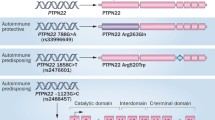Abstract.
CD45, encoded by the protein tyrosine phosphatase receptor type C (PTPRC) gene, is essentially involved in maturation, activation, and migration of immune cells. Lack of CD45 results in severe immunodeficiency, and alterations of the receptor may result in autoimmunity. Here, we describe a novel mutation in PTPRC as a cause of variant CD45 expression in humans. Several members of a multiple sclerosis multiplex family showed expression of CD45RA on memory T cells and monocytes. The variant expression pattern was linked to the PTPRC gene by DNA microsatellite studies. DNA analysis identified a novel point mutation in exon 4 (position 59 C→A) in all family members with variant CD45 expression, but not in donors with normal CD45 expression. The mutation interferes with alternative splicing and alters amino acid sequence (H→Q), interfering with antibody binding to the CD45RA domain. Overall, we describe the first mutation in PTPRC that interferes with splicing and results in surface expression of a structurally altered CD45 molecule in humans.
Similar content being viewed by others
Author information
Authors and Affiliations
Additional information
Electronic Publication
Rights and permissions
About this article
Cite this article
Jacobsen, M., Hoffmann, S., Cepok, S. et al. A novel mutation in PTPRC interferes with splicing and alters the structure of the human CD45 molecule. Immunogenetics 54, 158–163 (2002). https://doi.org/10.1007/s00251-002-0455-7
Received:
Revised:
Issue Date:
DOI: https://doi.org/10.1007/s00251-002-0455-7




